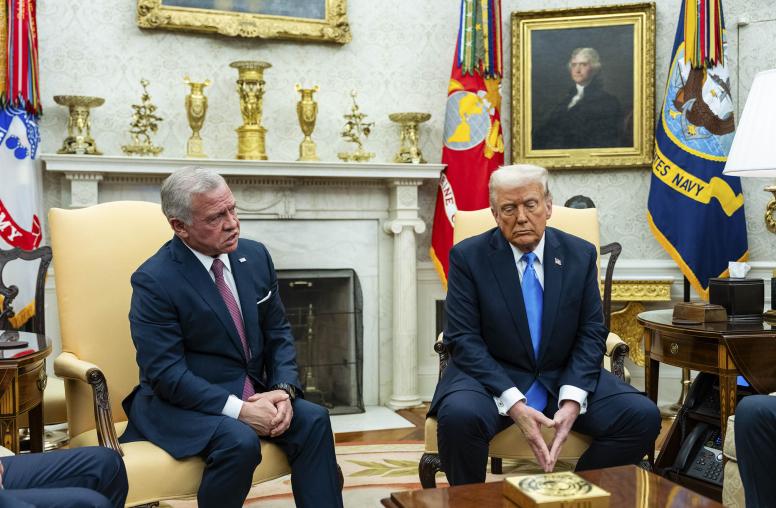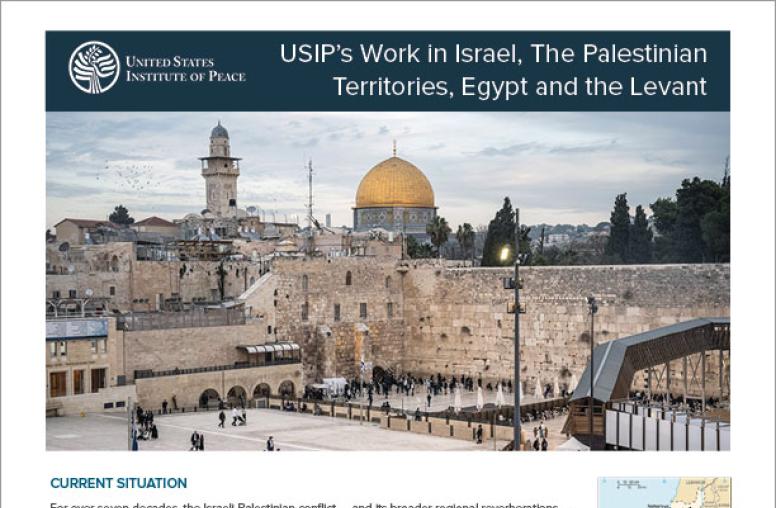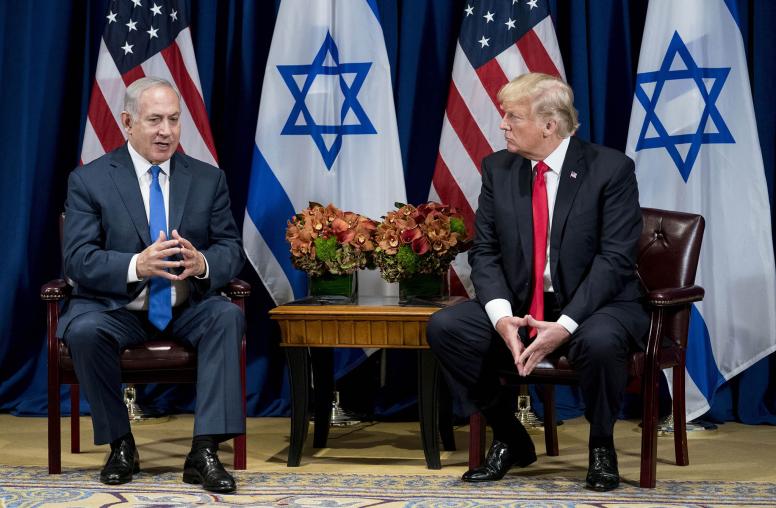In Gaza, Israelis and Palestinians Face a Common Foe in Coronavirus
The COVID-19 threat underscores the interconnectedness of Israeli and Palestinian interests.
On March 22, authorities in Gaza affirmed the inevitable: the first two confirmed cases of COVID-19 in the Gaza Strip. Gazan officials reported that the two men were immediately quarantined upon entry via Egypt’s Rafah border crossing with the enclave and have remained there, along with all those who had been in contact with them. Yet, since then, the number of confirmed cases has jumped to 10, and the question of how long a further spread of the virus into Gaza can be contained weighs heavily for this densely populated territory, long beleaguered by wars and severe deficiencies in its health care infrastructure.

The now oft-repeated and proven adage that diseases don’t respect borders means that concern over a large-scale outbreak of the novel coronavirus in Gaza is shared by Palestinians and Israelis alike. As such, this latest crisis raises questions about the immediate- and longer-term implications and possibilities for cooperation between these parties, entrenched in conflict with each other—yet now facing a common and lethal foe.
Gaza's Dire Baseline
USIP gleaned some insights into the dangers and potential opportunities presented by this all-too-real and unfolding scenario through a June 2018 simulation exercise jointly ran with the Atlantic Council’s Scowcroft Center for Strategy and Security. That exercise—centered on a fictitious cholera outbreak in Gaza—was designed to test the capabilities of stakeholders to act alone and multilaterally to stem an immediate public health crisis in the enclave and to address the broader set of challenges underlying that territory’s persistent cycle of conflict and crisis.
Through the exercise, we sought to simulate the actions and reactions of the Israeli and Palestinians leaderships, Palestinian factions, regional actors, the broader international community, international organizations, and civil society actors in the face of such an unfolding crisis. Then, as now, Gaza’s baseline situation was dire. Intersecting public health, water, and energy crises raise critical questions about the territory’s ability to implement adequate prevention measures against a viral spread, let alone about its capacity to treat those infected.
According to a 2018 RAND report, some 97 percent of the ground water from Gaza’s coastal aquifer—the enclave’s only source of fresh water—is unfit for human consumption, with further implications for sanitation and hygiene. In addition, Gaza has long suffered from a chronic shortage of medical equipment, drugs, specialist medical practitioners, and hospital beds, and the healthcare system is already overburdened by patients injured in the violent confrontations at the fence bordering Israel. Moreover, according to Gazan Health Ministry officials, the Strip only has 65 ventilators that are already in high demand and will need at least an additional 150 such machines to adequately confront the crisis. This is in addition to a dearth of protective gear and disinfectants for use in clinical settings.
Meanwhile, the United Nations Relief Works Agency (UNRWA), responsible for a significant proportion of healthcare services in Gaza, is launching a desperate appeal for increased funding to address the unfolding crisis. In recent testimony to the House Appropriations Subcommittee on State, Foreign Operations, and Related Programs, the executive director of UNRWA’s USA National Committee, Mara Kronenfeld, noted that the organization began 2020 with debts of $55 million and asked Congress to reverse the Trump administration’s 2018 decision to cut all funding to the organization, and restore it to the previous annual levels, to include $225 million for programs in the West Bank, East Jerusalem, and the Gaza Strip. This is in parallel with a call to other donor states for $14 million to address the COVID-19 crisis.
The requests come against an urgent socioeconomic backdrop. According to the Palestinian Social Affairs Ministry, at least 50,000 families have been added to the Palestinian Authority’s list of emergency social welfare aid since the coronavirus outbreak. Many families are affected by emergency measures by both Israeli and Palestinian authorities that have restricted movement, impacting Palestinian day laborers who typically travel back and forth between Israel and the Palestinian Territories to earn a living, and West Bank and Gaza business owners who’ve been required to halt their operations.
Crisis and Cooperation
In cautiously optimistic news for the immediate term, what we learned from our simulation was that in the face of a high-stakes public health crisis that would severely impact Gaza, and with implications for neighboring Israel and Egypt, stakeholders initially put aside politics, garnered resources, and cooperated to avert an epidemic. An additional hopeful consideration here is that, since 2018, quiet cooperation between Israel and the Hamas authorities governing Gaza has grown, marked in January of this year by a set of unofficial “understandings” aimed at reducing violence and ending longstanding travel and trade restrictions. With Israel’s acquiescence and coordination, Qatar has been regularly infusing much-needed aid and fuel assistance into Gaza. Together, this means that a foundation is already in place upon which intensified crisis cooperation can build.
Indeed, Qatar has reportedly stepped up its funding to Gaza in recent days to specifically address the novel coronavirus situation, while the EU has announced provision of 82 million euros in annual support to UNRWA, and Israel has allowed the passage of an initial 200 coronavirus test kits to Gaza. At the same time, the World Health Organization has announced its support for the establishment of a field hospital at the Rafah crossing, and as the virus has spread through Israel and the West Bank in recent weeks, there has been strong cooperation between Israeli and Palestinian authorities to prevent a larger-scale outbreak, even at an otherwise particularly fraught moment in Israeli-Palestinian relations.
Likewise, of note during our simulation, violent spoilers in the context of the Israeli-Palestinian conflict largely kept at bay while the crisis unfolded, allowing focus to remain on the public health concern at hand. We already see signs of a parallel reality today, with a tenuous calm taking hold between Gaza’s various armed groups and Israel.
But how long can this hold? In our simulation, staving off the immediate crisis at the outset was a heavy lift, but doable. The next step—stabilization and sustainability measures—proved more challenging. Interests aligned to avert disaster, but diverged in how actors sought longer-term solutions, leading to intransigence and inaction. Ultimately, in our simulated exercise, two plans developed out of the initial crisis: a humanitarian and development plan led by the United Nations, and an effort to parlay the situation into a Palestinian political reconciliation effort led by Egypt.
Is Continued Cooperation Possible?
However, the inability of different actors to rally conclusively or with consensus behind one or both initiatives exposed the challenge presented by a field of multiple stakeholders with distinct and often competing interests. Once the initial health crisis was averted, the pressure to act or to concede on independent interests declined for all stakeholders. A contained Gaza remained a comfortable-enough status quo for all but Gazans themselves. The parties had simply bought time until a new crisis emerged. It was too heavy of a lift to harness the necessary collective action to produce progress on status quo ante challenges such as Palestinian political reconciliation or an Israel-Hamas cease-fire.
This should be the warning and call to action in the current reality. Unlike the example of cholera used in our simulation, COVID-19 is an infection that still defies clear answers on treatment and containment measures and—if it takes hold in Gaza—is likely to require a far-longer timeline of cooperation and more drastic set of measures than was envisioned in our cholera-based exercise. In addition, in today’s real-world crisis, neighboring Egypt and Israel are already themselves impacted by COVID-19, constraining their ability to focus solely on prevention in Gaza.
In recent weeks alone, as the stark magnitude and urgency of the COVID-19 threat has hit Israel and the Palestinian Territories, it has underscored the interconnectedness of Israeli and Palestinian interests. “The outbreak of the coronavirus must be a wake-up call to the fact that promoting cooperation over our shared environment is needed not just in emergencies, but every day,” said Gidon Bromberg, the Israeli co-director of the joint Israeli-Palestinian and Jordanian environmental organization EcoPeace Middle East. Nidal Fuqaha, director of the Palestinian Peace Coalition, struck a similar tone in noting that the crisis sends a “clear message to both Israelis and Palestinians that the issue of cooperation and coordination, and arranging or dealing with such situations jointly, is a must.
These leaders in the civil society, who struggle to foster peacebuilding through radical cooperation, must be supported in their work, and have their efforts reinforced by leadership from the top. The dynamics of our simulation exercise suggested that a longer-term solution to the persistent challenges of Gaza—challenges that leave it particularly vulnerable to external crises—will ultimately require decisive leadership by one or two key third-party actors who can exercise leverage and align international efforts.
The looming threat of a long battle against COVID-19 is a daunting and sobering prospect for Israelis, Palestinians, and all relevant actors in this region already beset by the hardships of conflict. But now is the time to harness the opportunity. Stakeholders typically locked in conflict and confrontation with each other must arm themselves with a longer-term mindset of sustained calm, cooperation, and creativity to jointly combat this common foe.



